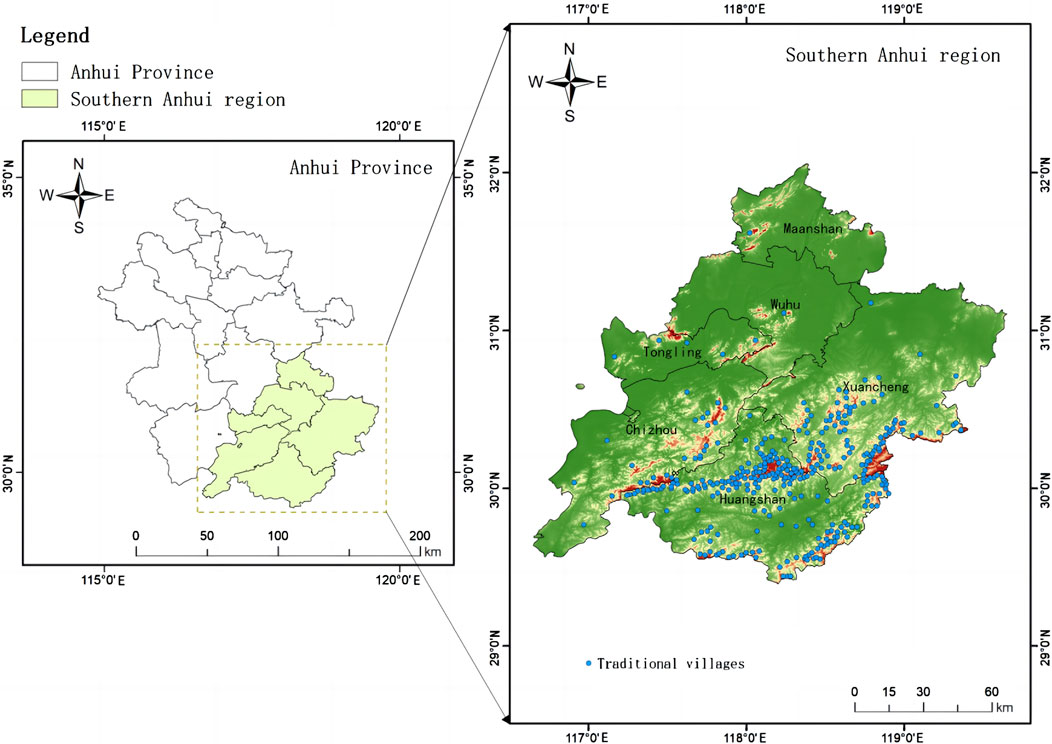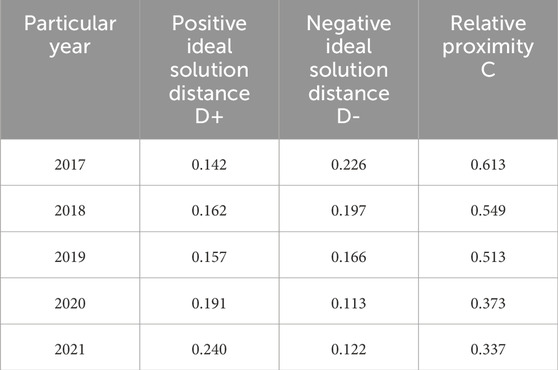- 1Anhui Cultural Tourism Innovative Development Research Institute, Anhui Jianzhu University, Hefei, China
- 2School of Arts, Anhui Jianzhu University, Hefei, China
- 3Social Innovation Design Research Centre, Anhui University, Hefei, China
The development of the tourism industry is a crucial mechanism for enhancing the tertiary sector and promoting local economic growth. This study focuses on traditional villages in the southern Anhui region, analyzing the characteristics of the evolution of their tourism spatial structure and the underlying driving forces. The objective is to provide foundational insights for rural tourism and policy development in the region. Utilizing ArcMap 10.8, we assess the evolution of the tourism spatial structure through the selection of 14 indicators across three dimensions: resource endowment conditions, the regional tourism development environment, and the local economic construction environment, thereby establishing an evaluation system. The Entropy Weight-TOPSIS method is employed for comprehensive data analysis. The findings indicate: 1) The development status of tourism in traditional villages is gradually declining, significantly impacted by the pandemic; 2) Among the six cities in southern Anhui, Huangshan and Wuhu exhibit relatively favorable development conditions, while Ma'anshan and Xuancheng are at moderate levels. Chizhou and Tongling are facing weaker development states; 3) Regional investment, commercial value, and ecological environmental protection capabilities are the three primary driving factors influencing the evolution of tourism spatial structure in southern Anhui, followed by environmental quality and cultural heritage preservation. Therefore, policymakers should place greater emphasis on boosting tourism development in Chizhou and Tongling, enhancing regional investment levels, and improving the commercial value and ecological protection capabilities of tourism spaces. Furthermore, attention must be devoted to environmental quality and cultural heritage preservation within the rural tourism landscape of southern Anhui to ensure sustainable development.
1 Introduction
Ancient villages, also known as traditional villages, possess a wealth of both tangible and intangible cultural heritage, along with significant historical, cultural, scientific, artistic, social, and economic values (Zheng et al., 2021). Since 2012, the Ministry of Housing and Urban-Rural Development of China, in collaboration with several ministries and commissions, has designated 6,819 villages as “Chinese traditional villages” (Gao et al., 2023). Southern Anhui Province is particularly rich in traditional villages, with ancient villages such as Xidi and Hongcun recognized as World Cultural Heritage sites. The promotion of China’s rural revitalization strategy has spurred the development of the rural cultural tourism industry, making traditional villages a popular travel choice. These villages are the roots of the nation and the cradle of its culture, providing significant economic benefits as vital tourism resources (Liu C. et al., 2022). Rural tourism activities not only foster the recovery of rural areas but also help preserve local history, nature, cultural heritage, and the environment, thereby facilitating the sustainable development of traditional villages. Moreover, such activities can enhance local advantages in terms of policy, capital, and technology (Li et al., 2023). To accommodate the demands of rural tourism, various infrastructure projects are encroaching upon the production (Nie C. et al., 2022; Chen et al., 2011), living, and ecological spaces of traditional villages, thereby reshaping their spatial structure (Jimura, 2011), layout (Tucker, 2001), landscape patterns (Frisv, 2012), and modes of production and living (Zheng et al., 2024), ultimately creating distinct spatial characteristics. While catering to the needs of residents, traditional villages must also address the requirements of related tourism industries and visitors.
The spatial evolution of tourism constitutes a significant aspect of tourism geography research. The objective of this research is to explore and understand the development processes and characteristics of tourism destinations over a defined period (Chen et al., 2023). Since the 1990s, studies related to tourism in traditional villages have emerged in countries such as the United Kingdom, Japan, and the United States, focusing on the evaluation of local indigenous populations and their associated impacts (Chen et al., 2021), the sustainability of tourism in traditional villages (Wang, 2021), and the transformation of local lifestyles and production methods (Yang et al., 2019). In terms of the geography and spatial structure of tourism, Landry uses the rural areas of Tuscany as an example to illustrate that existing weak structures in the countryside, along with a significant number of vacant buildings, have contributed to the gradual development of tourism in these areas. Ramaano (Professor of Environmental Science and Ecology, University of KwaZulu-Natal) investigates the potential role of GIS in fostering inclusive and sustainable rural tourism within the context of community-based development and natural resource management (CBNRM) across Southern Africa and numerous other rural areas globally (Xiong et al., 2023). Most relevant foreign studies have utilized ASEB raster analysis of tourist experience, decision laboratory analysis, and GIS analysis, yet fewer have employed multiple indicators for assessment and decision-making analysis. A considerable number of domestic scholars have engaged in in-depth discussions regarding the spatio-temporal patterns of traditional villages and their influencing factors. Historically, research on traditional villages has primarily concentrated on the cultural value and significance of these villages, the sustainability and vitality of village architecture and culture (Fu et al., 2023), the layout of traditional villages (Liu et al., 2019), the cultural landscapes of traditional villages (Chianc et al., 2013), the environmental factors influencing their formation (Huanc et al., 2022), and the tourism development of these villages (Chen et al., 2020). Research findings indicate that village endowment is a fundamental force, market dynamics are a decisive force, and government involvement plays a leading role in the development of tourism activities (Mbalwa and Sakuze, 2009). Currently, studies on the tourism space of traditional villages are mainly focused on spatial form (Mokoena, 2019), cultural value (Purnamawati et al., 2022), and industry influences (Nie ZY. et al., 2022), with research on traditional villages in the southern Anhui region predominantly concentrating on cultural expression (Fu et al., 2021), ecological environments (Postalci and Atay, 2019), and heritage protection (Liu Q. et al., 2022). Notably, studies on the evolution of the spatial structure of tourism remain incomplete, with a noticeable gap in research on both the evolution of spatial structure and its driving forces.
The term “tourism spatial structure” was first defined by Bian Xianhong (Yuan et al., 2014) as the interplay of various factors inherent to tourism development, which collectively manifest in distinct spatial forms. The spatial structure of tourism encompasses various components, including the spatial structure of tourism transportation, landscape, resources, and markets. Its primary constituents consist of the distribution of tourism resources, the transportation network system, the configuration of tourism facilities, and the patterns of tourist flow. Factors influencing the spatial structure include geographic, economic, cultural, and policy-related elements. The evolution of tourism spatial structure reflects the spatial development of tourism and the dynamic relationship between regional development and tourism activities (Sun et al., 2016). Examining the structural development of tourism spaces enables the various components within the spatial framework to interact more cohesively while simultaneously enhancing the tourism system (Dang and Yao, 2013). Investigating the evolution of tourism spatial structures in villages holds substantial significance for the subsequent improvement of the rural tourism industry and the sustainable development of traditional villages (Jungguang et al., 2017). Furthermore, analyzing the evolution and characteristics of tourist destinations allows researchers to test fundamental principles of tourism development and uncover key issues associated with different developmental stages of these destinations (Bin et al., 2019). This approach aids in identifying future trends and directions for tourist destinations, providing valuable scientific guidance for their development. In their exploration of spatial structural evolution, researchers have not only concentrated on the spatial arrangement and structural changes within villages but have also broadened their perspectives to include internal and external factors influencing their evolution. This expansion of focus reveals the complexity and multidimensionality inherent in the evolution of spatial structures.
This study will investigate how villages in the southern Anhui region are influenced by the conditions of village resource endowment, the regional tourism development environment, and the local economic development environment, as well as the roles these factors play in the evolution of the spatial structure of traditional village tourism. To support this investigation, indicator data from the southern Anhui region spanning 2017 to 2021 will be collected. Utilizing the TOPSIS method and ArcGIS 10.8 software, the data related to village resource endowment, regional tourism development, and local economic development will be analyzed to assess the significance of each indicator within the system. By employing GIS, the evolution of the spatial structure of traditional villages and their driving factors will be monitored at multiple scales, allowing for the analysis of geographic differentiation patterns and the characteristics of their evolution (Chunyou et al., 2017). The researcher aims to propose relevant suggestions and strategies based on these findings to inform rural revitalization policies and optimize the spatial structure of village tourism.
2 Study area
The current study area is the South Anhui region (Figure 1), located south of the Yangtze River in Anhui Province, China. This region connects to the Yanjiang Plain and is in proximity to Jiangsu, Zhejiang, and Jiangxi. The approximate geographical extent of the South Anhui region spans latitudes 29°31′to 31°N and longitudes 116°31′ to 119°45′E, encompassing six cities: Chizhou, Xuancheng, Ma’anshan, Wuhu, Huangshan, and Tongling, with a total area of 31,200 square kilometers. The South Anhui region includes both the South Anhui mountainous area and the South Anhui river plain, featuring two major mountain systems: Jiuhua Mountain and Huangshan Mountain. Its topography is characterized by hills and mountains, coupled with a humid climate and rich vegetation, which provide favorable natural conditions for the formation of villages.
Traditional villages in southern Anhui Province flourished due to financial assistance from Huizhou merchants during the Ming and Qing dynasties. Upon returning to their hometowns, these merchants constructed homes in aesthetically pleasing styles, contributing to the unique natural scenery and rich historical character of the area. The architectural style of ancient villages in southern Anhui is distinct from that of traditional farming society, fostering in local residents a richer mindset and an openness to their heritage, as well as a profound appreciation for local history, tradition, and culture. Traditional houses in southern Anhui employ various decorative techniques, such as meticulously maintained gardens, carefully excavated lakes, exquisite potted plants, and intricate wooden reliefs, to create an atmosphere of serenity and beauty that reflects the residents’ refined craftsmanship and deep cultural heritage.
The tourism spatial structure of traditional villages in the southern Anhui region is characterized by agglomeration, functional zoning, ecological friendliness, and diverse development modes. This region serves as a concentrated hub for traditional village development in Anhui Province, exhibiting strong resource agglomeration within its tourism space. As of June 2019, among the five batches of “Chinese Traditional Villages” designated by China, over 400 villages are located in Anhui Province, with 92% situated in the southern Anhui region. In the context of rural revitalization policies and local economic development, tourism has emerged as a leading force in the tertiary sector, developing rapidly; notably, in 2011, traditional villages in southern Anhui were awarded the status of national AAAAA tourist attractions (Guangming Daily, 2023). The rise of tourism has significantly impacted the spatial structure of traditional villages, which, in turn, has provided a foundation for the tourism industry. The tourism spatial structure in southern Anhui villages features a hierarchical distribution of functions, including cultural preservation areas, commercial zones, natural resource areas, and residential neighborhoods. This division of functional areas optimizes tourist mobility and enhances the overall tourism experience. A vast number of traditional buildings and residences, which possess similar forms and unique characteristics, serve as the primary routes for tourists to engage with local culture, forming a distinct “cultural corridor.” The approach of integrating ecological protection with cultural heritage promotes the sustainability of tourism spatial development in the southern Anhui region.
However, the tourism development model varies among villages in different regions, necessitating that researchers consider the relevant geographic environment, cultural heritage, and socio-economic factors specific to local conditions. For instance, the transportation networks in major tourist villages in southern Anhui are relatively well-developed, while some more remote villages may have inconvenient transportation facilities for visitors, impacting their tourism spatial structure. Additionally, due to local cultural influences, community structures, and economic foundations, the degree of local community participation in tourism activities varies from village to village.
3 Research methodology and data sources
3.1 Research methodology
The entropy weighting method is designed to objectively assign weights to each indicator (Han and Trimi, 2018). The concept of “entropy” originates from physics and indicates the degree of disorder inherent in a system. Drawing on the idea of information entropy (Shi and Sun, 2023), a higher entropy signifies increased chaos within the system, greater uncertainty, less information, and consequently, a lower weight (Sun, 2010). The weight calculation criterion of the entropy weighting method is based on the numerical discrete degree of each index, effectively excluding subjective influencing factors and enhancing the objectivity of research results (Xiong and Zeng, 2007).
The TOPSIS method, also known as the “Distance to Superiority and Inferiority Solutions Method” or the “Ideal Point Method,” aims at ranking items by evaluating their relative merits based on proximity to an ideal target (Yu, 1984). The combination of the entropy weighting and TOPSIS methods has been widely utilized in various assessment-based studies (Niu, 1988). By adopting the entropy-weighted TOPSIS method, the weight of each indicator can be determined more accurately, thereby improving the ordering of the evaluation objects (Robert and Gottlieb, 1998). This method objectively reflects the importance of each indicator within the overall system and clearly demonstrates changes in indicator weights over time, thus facilitating the regional implementation of potential assessment studies (Hannigan, 1994).
The entropy-weighted TOPSIS method is particularly suitable for this study, as it allows for the objective measurement of the openness level of digital platforms. In contrast to the Analytic Hierarchy Process (AHP), which requires expert ratings to determine weights, the entropy-weighted method provides a more objective alternative.
A Geographic Information System (GIS) effectively collects various data regarding the spatial structure of tourism, including geographic coordinates, distribution of tourism resources, and transportation networks. It presents these data in the form of maps, charts, and other visual formats. Utilizing the visualization and spatial analysis capabilities of GIS, the evolving trends and potential issues in the tourism spatial structure can be clearly illustrated, aiding in a better understanding of its current state and characteristics, while facilitating the formulation of more accurate and effective tourism development strategies.
The specific process of this study is as follows: first, an indicator system comprising three dimensions is constructed based on the evolution of the spatial structure of traditional village tourism. Second, the required data is collected and organized using the Statistical Yearbooks of Chizhou City, Xuancheng City, Ma’anshan City, Wuhu City, Huangshan City, and Tongling City, alongside data from search engine websites. Third, a comprehensive evaluation of traditional villages in southern Anhui is conducted using the SPASSAU platform, analyzing the horizontal development level of traditional village tourism space across the six cities with the entropy-weighted TOPSIS method. This analysis includes a comparison with the optimal program and utilizes data from 2017 to 2021 for a longitudinal comparative study.
3.2 Indicator creation
The resource conditions and levels of tourism industry development vary across cities in the southern Anhui region, with corresponding differences in the status and development of traditional villages. Consequently, this study selects 14 indicators from three dimensions: village resource endowment conditions (Jianc and Lin, 2022), regional tourism development environment (Hu et al., 2021), and local economic development environment (Xiao et al., 2022). These indicators are utilized to construct an evaluation index system for the spatial structure of traditional village tourism in southern Anhui (Table 1). By analyzing the evolution of the spatial structure of traditional village tourism, this research aims to uncover its intrinsic driving forces and the characteristics of spatial and temporal differentiation.
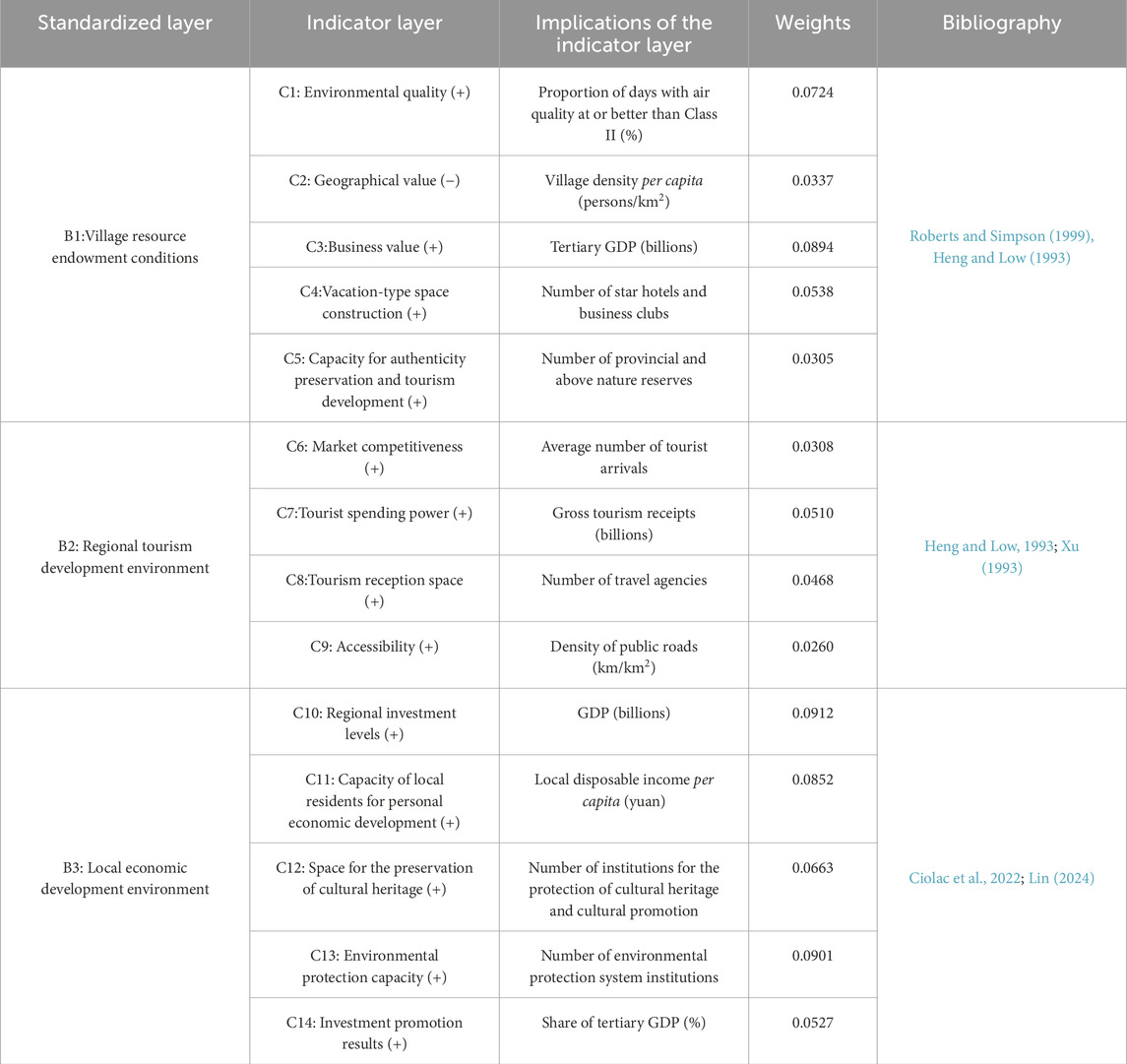
Table 1. Weights of driving factors for the spatial structure of traditional village tourism in South Anhui region in 2021.
The conditions of village resource endowment serve as the foundation for the development of the rural tourism industry and encompass five factors: environmental quality, territorial value, commercial value, the construction of vacation-type spaces, and the capacity for originality protection and tourism development. Among these, the per capita density of villages functions as a negative indicator of regional value; as per capita density increases, the villages become more crowded, thereby diminishing regional value. The original ecological environment, local industrial development, architectural styles, and other factors in the southern Anhui region contribute to its unique cultural charm, which significantly attracts tourists. Traditional villages in southern Anhui possess historical and cultural value, along with substantial development potential. Effectively leveraging their diverse cultural heritage and distinctive natural landscapes for tourism development and promotion can draw more visitors and position these villages as vital tourism resources and economic pillars of Anhui Province.
The tourism market environment in the southern Anhui region plays a crucial role in shaping the development and evolution of traditional village tourism. This study identifies four key indicators: market competitiveness, tourists’ consumption capacity, tourism reception space, and transportation accessibility, which collectively constitute the regional tourism development environment. Currently, China’s economy is experiencing rapid growth, with per capita disposable income on the rise, concurrently driving the expansion of the tertiary industry. As the tourism consumption market evolves, traditional sightseeing has gradually transformed into a comprehensive, culture-oriented travel model, attracting more visitors to farms to engage with local history, customs, and folklore. Additionally, transportation infrastructure in each village has become a critical factor in the tourism industry’s development, continually enhancing connections between traditional villages and the broader world.
The local economic development environment facilitates structural changes in the tourism landscape of villages in southern Anhui, influenced by several key factors including the level of regional investment, the capacity for local residents’ economic development, cultural heritage protection space, environmental protection capabilities, and the effectiveness of investment attraction strategies. A favorable investment environment promotes stable economic growth, which in turn enhances and upgrades tourism infrastructure. This local economic development supports improved cultural and environmental protection measures, safeguarding the originality and uniqueness of the area and ensuring a sustainable tourism environment. To meet tourists’ consumption demands and psychological expectations, their spending levels often exceed those of local residents. Furthermore, as the number of tourists increases, local residents may experience heightened pressure on their livelihoods; thus, robust economic capacity can help mitigate the impacts of tourism development on them.
3.2.1 Data sources
The evaluation index system in this study comprises a total of 14 indicators. To ensure the validity and objectivity of the research results, data spanning 5 years, from 2017 to 2021, were utilized. This data primarily originates from the statistical yearbooks (2017–2021) of each city in the southern Anhui region (Huangshan, 2024; Wuhu, 2024; Ma’anshan, 2024; Xuancheng, 2024; Tongling, 2024; Chizhou, 2024). Additionally, the data concerning environmental quality and tourists’ consumption capacity for certain cities were sourced from search engine websites. The data were organized and analyzed using relevant software, such as SPSSAU and ArcMap 10.8. The year 2021 was selected as a representative year to examine the evolution of the spatial structure of traditional village tourism in the southern Anhui region and its intrinsic driving forces.
3.2.2 Data processing
By integrating the entropy weight method with the TOPSIS method, a comprehensive assessment system can be developed. In this framework, different assessment indices are assigned appropriate weights, enabling a systematic grading based on their strengths and weaknesses (Xiong et al., 2023). The combination of both the entropy weight method and the TOPSIS method significantly enhances the reliability of the study while effectively mitigating the uncertainty associated with the entropy value method and the subjectivity inherent in the TOPSIS method. The specific application steps of the entropy weight TOPSIS method are as follows Equations 1–15:
1) Create the original data matrix
X original data matrices are constructed by taking n reference values from m samples.
In this equation, xij denotes the value of the jth covariate for the ith sample.
2) Infinite dimensionless processing of raw data
Extreme value processing was used to convert the raw data into a dimensionless format that could be compared for better analysis and processing of the data.
Treatment formula for positive indicators:
Equation for the treatment of negative indicators:
3) Normalization of indicators
A complete weight matrix is constructed by calculating the weight of object i in the jth indicator.
Where, 0 ≤ Ρij ≤ 1.
4) Calculate the entropy value of each indicator
Assuming that e j is the entropy value of each index, the entropy value is calculated as follows:
Where 0 ≤ ej ≤ 1. In entropy calculation, when Pij is less than or equal to 0, it should be used as the basis of 0 and then 1 should be added to realize the logarithmic calculation, and this method is called mean difference method.
5) Derive the coefficient of variation
The coefficient of variation for the jth indicator is gj, calculated as follows:
6) Derive weights for each indicator
The weights of the j indicators can be calculated using the following formula:
Weighted normalized matrix for each indicator
8) Determine the optimal and worst solutions
The optimal solution is S+ j, and the worst solution is S - j, which is calculated as follows:
9) Euclidean distance calculation
The difference between each indicator object and the best and worst solutions can be calculated by applying the formula as follows:
10) Calculate the composite evaluation index for each indicator.
In the formula, the value of C i ranges from 0 to 1, in which the closer C i is to the value of 1, the better the level of the evaluation object; if C i is closer to the value of 0, the worse the level of the evaluation object.
Calculated and assessed according to the above process, the weights of the indicators of the evaluation system for the evolution of the spatial structure of tourism in traditional villages in southern Anhui Province are derived, as shown in Table 2.
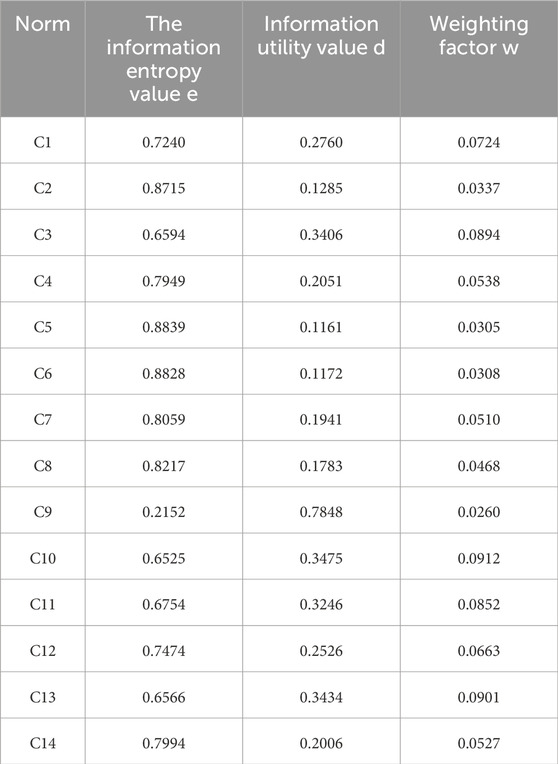
Table 2. Indicator weights of the evaluation system for the evolution of the spatial structure of traditional village tourism in the southern Anhui region.
4 Data results and analysis
The data generated using the entropy weighting method is analyzed through TOPSIS. In this context, the optimal ideal solution (positive ideal solution) refers to the decision scheme where the values of each attribute attain their maximum, while the negative ideal solution corresponds to the decision scheme where these values reach their minimum. By evaluating the standardized attribute values, one can identify the optimal and worst values for each attribute and thereby construct both the optimal ideal solution and the negative ideal solution. Considering the weights and influences of each indicator across the six villages allows for a more accurate and objective assessment of their strengths and weaknesses, which facilitates the formulation of targeted recommendations and strategies.
4.1 Comprehensive evaluation of traditional villages in southern Anhui region
From 2017 to 2021, the TSS composite index for traditional villages in the southern Anhui region decreased from 0.613 to 0.337. The CIOTSS values during this period were 0.613, 0.549, 0.513, 0.373, and 0.337, respectively (Table 3). This decline can be attributed to the implementation of relevant policies, the development of the villages, and the influence of external factors, which have collectively impacted the tourism industry in southern Anhui, resulting in a state of decline.
To conduct a more scientific and intuitive comparison of the relevant data across several cities, the researcher extracted representative data for each Level 1 indicator and created corresponding charts (Figure 2). The spatial structure of tourism in traditional villages of southern Anhui Province is observed to be in a gradual decline (Figures 3–7), which can be further categorized into three distinct stages:
(1) The small decline stage from 2017 to 2019 (0.613–0.513) reveals significant trends. Data from indicator C4 indicates that the number of star-rated hotels in southern Anhui has been in long-term decline, coinciding with an increase in population density, which impacts the direction of the tourism industry. During the early stages of market development, when hotel supply was limited, the establishment of rating standards facilitated the standardization and high-quality growth of the industry, providing official endorsement and attracting consumers to rated hotels. However, as the hotel industry has become highly saturated, consumer demands have shifted significantly. The hotel evaluation system has diversified, making it challenging for a single star-rating standard to maintain its original appeal and influence. Notably, the number of five-star hotels has dramatically declined since peaking in 2017. Simultaneously, ongoing development and renewal of rural areas have resulted in increased village populations, leading to higher population density and reduced per capita living space.
(2) The significant downward phase from 2019 to 2020 (0.513–0.373) reveals crucial trends. According to the data presented in Table 2, the number of star-rated hotels and population density (C2) significantly impact the tourism space of traditional villages in southern Anhui; furthermore, the tourism reception space (C8) also plays an important role. Following the outbreak of the Xinguang epidemic, China’s tourism travel rate decreased by 50%. In 2020, the market competitiveness (C6) of the six cities reached its lowest point. Many offline travel agencies were compelled to implement furloughs and layoffs to preserve company funds. Smaller travel agencies, which typically rely on loans, gradually withdrew from the market. The tertiary sector (C3) also experienced a decline as people were unable to engage in entertainment due to the epidemic. Many tourist attractions closed to the public, leading to a significant reduction in tourist spending (C7).
(3) The stabilization phase from 2020 to 2021 (0.373–0.337) occurred during the ongoing epidemic outbreak, which continued to restrict the tourism industry, resulting in a contraction of travel agencies. According to the results of the domestic tourism sample survey, the number of domestic tourists in 2020 was 2.879 billion, a decrease of 3.022 billion compared to the same period in the previous year, representing a reduction of 52.1% due to the impact of the epidemic (Guangming Daily, 2021).
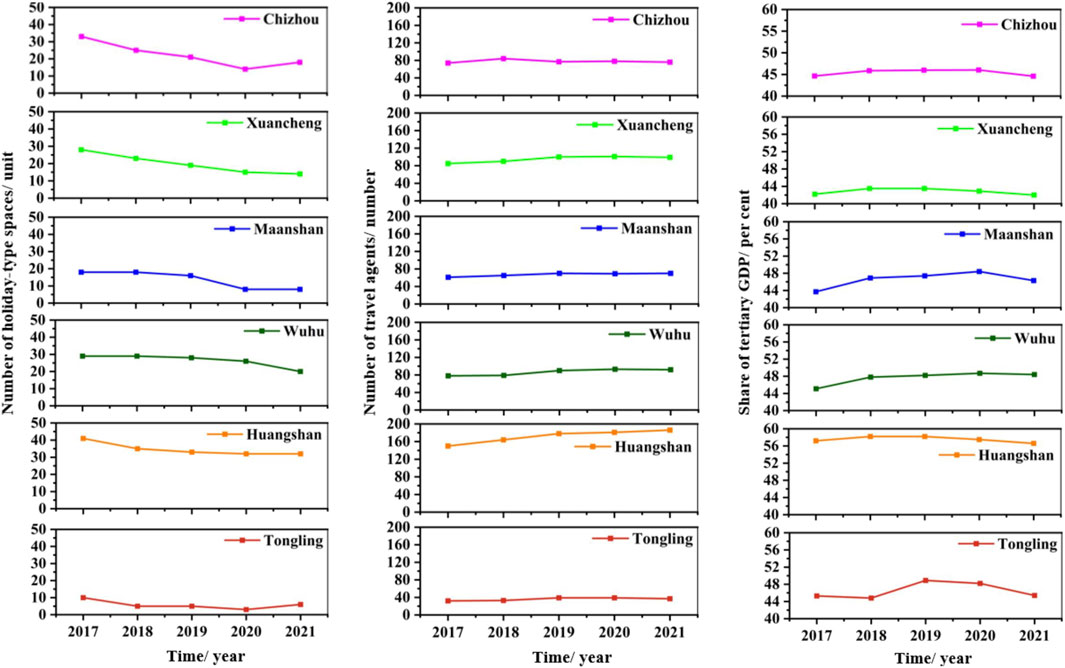
Figure 2. Number of Holiday Based Spaces, number of Travel Agencies and share of tertiary GDP in Six Cities, 2017–2021.
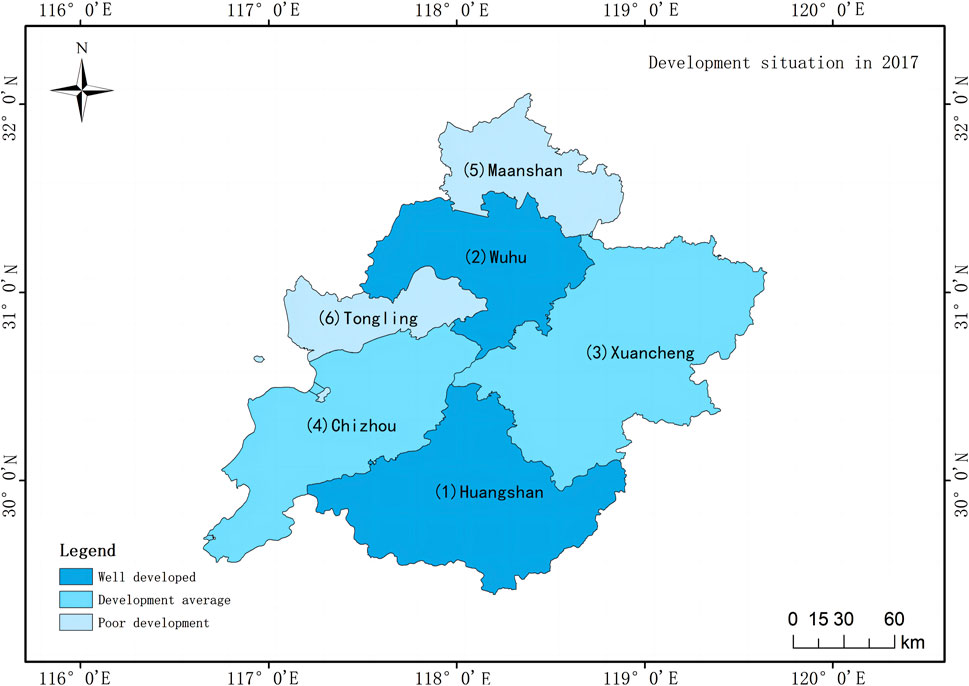
Figure 3. Distribution of spatial evaluation levels of traditional village tourism in each region of South Anhui, 2017.
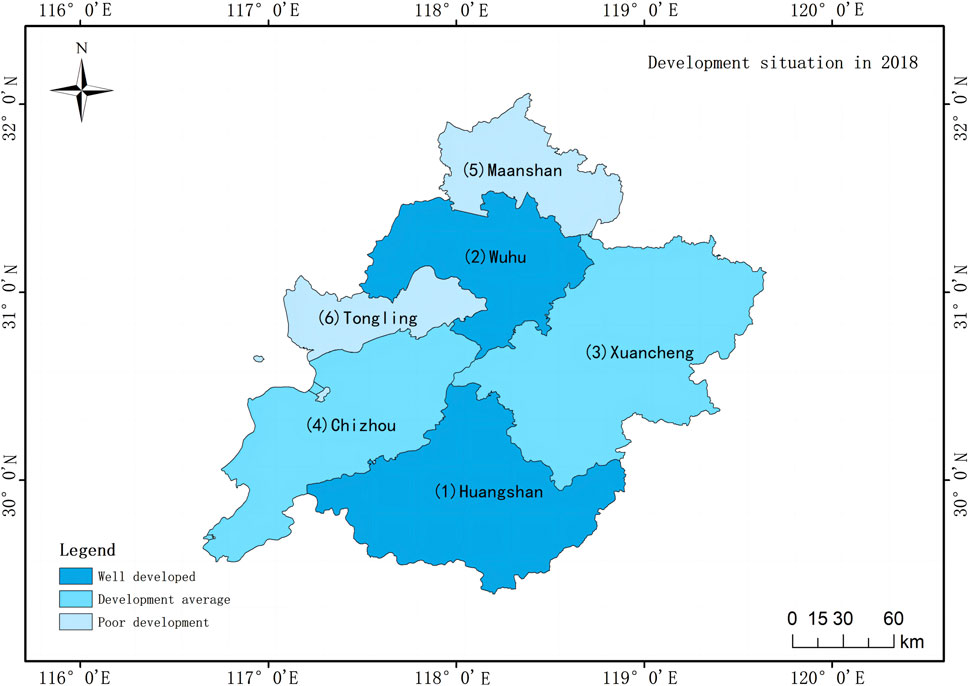
Figure 4. Distribution of spatial evaluation levels of traditional village tourism in each region of South Anhui, 2018.
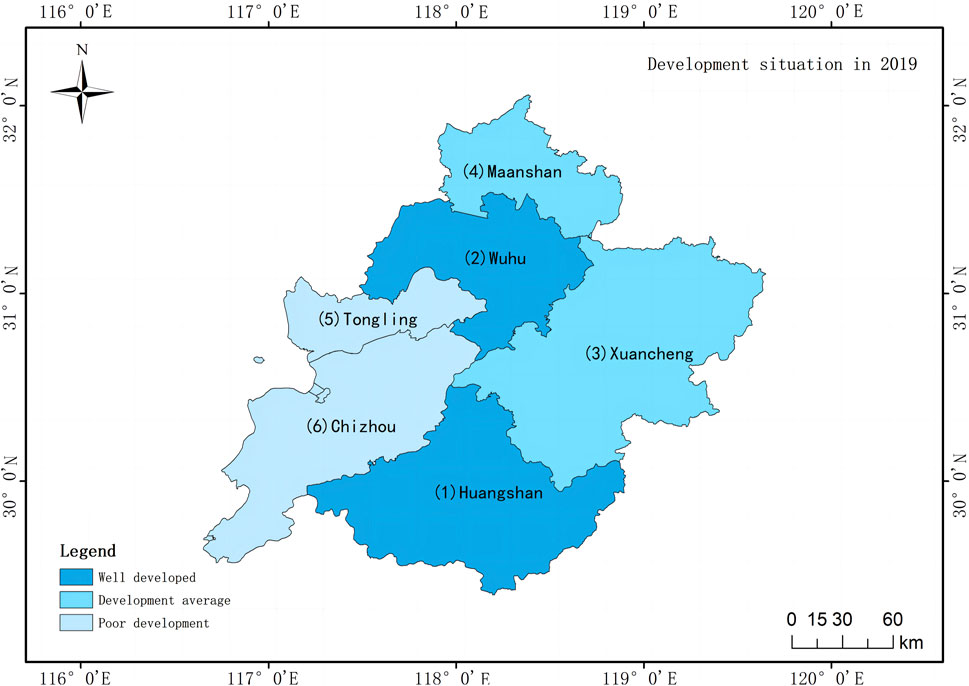
Figure 5. Distribution of spatial evaluation levels of traditional village tourism in each region of South Anhui, 2019.
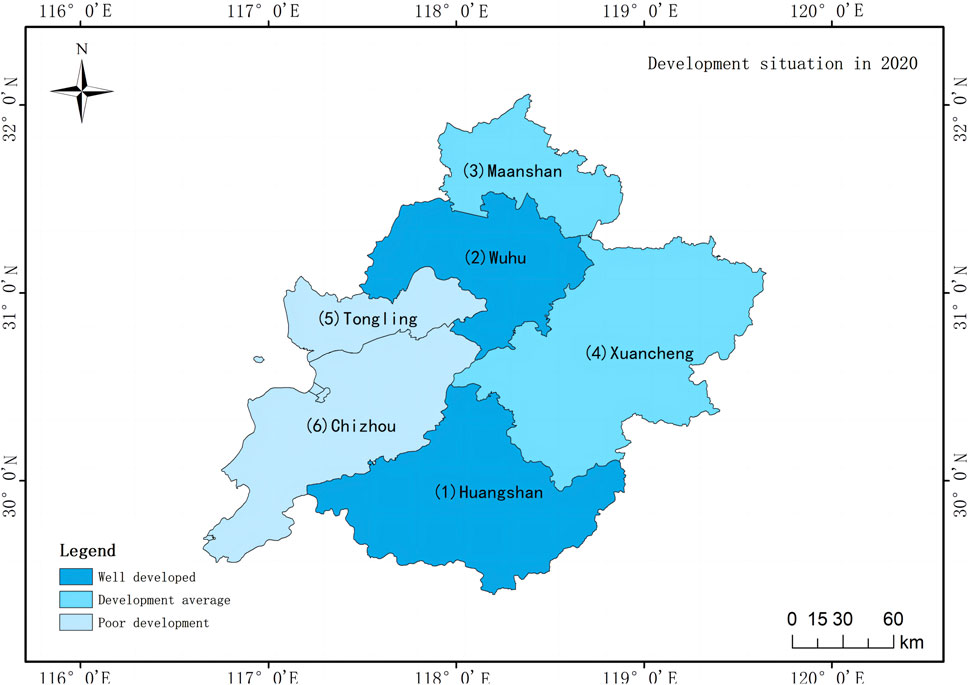
Figure 6. Distribution of spatial evaluation levels of traditional village tourism in each region of South Anhui, 2020.
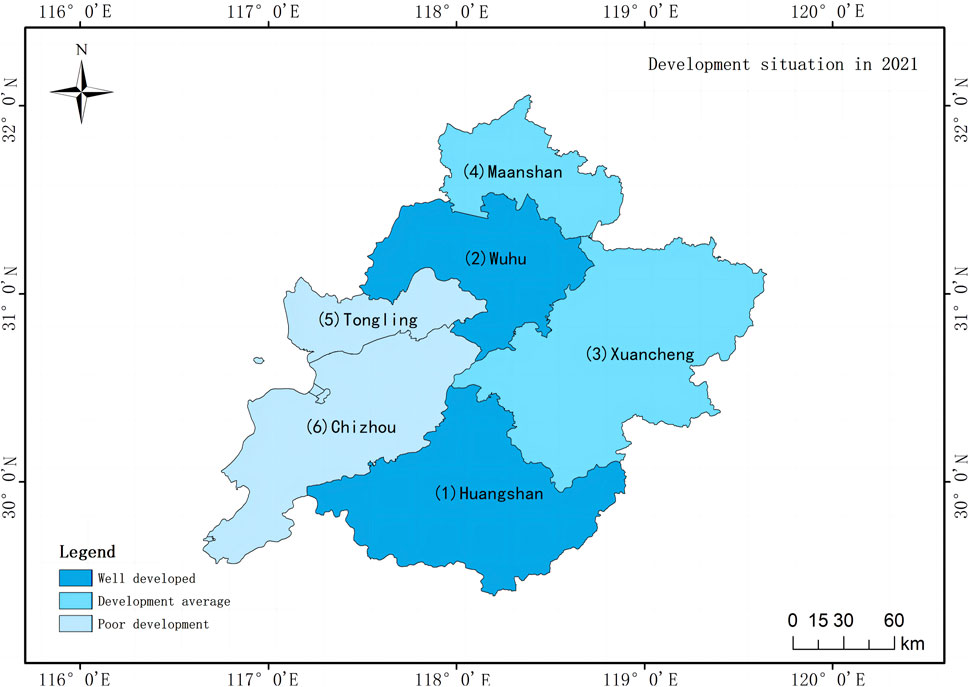
Figure 7. Distribution of spatial evaluation levels of traditional village tourism in each region of South Anhui, 2021.
4.2 Horizontal comparison of traditional villages in six cities in southern Anhui region
The entropy weight-TOPSIS method was employed to compare the relative proximity values of cities in the southern Anhui region (Table 4). The municipalities are ranked from high to low as follows: Huangshan (0.629), Wuhu (0.388), Xuancheng (0.269), Ma’anshan (0.266), Chizhou (0.218), and Tongling (0.214).
Among these, Huangshan is closest to the optimal ideal solution, demonstrating a significant gap with the other five cities, largely due to its ability to protect and develop tourism while maintaining authenticity (C5). Huangshan boasts nine provincial-level nature reserves, ranking first among the six cities. As of 2021, it has a total of 186 travel agencies and 32 star-rated hotels, attracting 63,124,000 visitors (Huangshan, 2024), making it the most competitive city in the market (C6). Wuhu, ranked second, has 92 travel agencies and 20 star-rated hotels, with a total of 48,944,000 visitors (Wuhu, 2024). In contrast, Tongling, ranked last, has only 37 travel agencies and 6 star-rated hotels, receiving 1,079,000 visitors (Tongling, 2024). Furthermore, data indicates that Huangshan’s transportation accessibility (C9) is limited, with a public road density of only 75.1 km/km2 in 2020, attributed to its unique geographical environment (Huangshan, 2024).
The gap between Wuhu and the optimal ideal solution is second only to that of Huangshan, which is closely associated with its business value (C3). Wuhu has the highest tertiary GDP, amounting to 208.4 billion yuan, securing its position in first place. It also boasts the fifth largest port on the Yangtze River, Jinghu Port, along with favorable conditions for agricultural development and high transportation accessibility (C9), featuring a public road density of 187 km/km2 (Wuhu, 2024). However, its environmental quality is subpar, ranking fourth among the six cities, indicating a need for greater emphasis on local natural environment protection.
Compared to the first two cities, the remaining four cities exhibit a larger gap from the optimal ideal solution due to various shortcomings. Xuancheng, which ranks in the middle, possesses the strongest environmental protection capacity (C13), with a maximum of 49 environmental protection organizations. However, it has fewer cultural heritage protection spaces (C12), with only 20 organizations dedicated to cultural relics protection and cultural promotion, reflecting a modest increase in their numbers (Xuancheng, 2024). Xuancheng’s traditional villages have a limited industrial structure, primarily relying on traditional agriculture and tourism, which results in low spending power (C7) among tourists. Tongling, ranked last, has the fewest travel agencies and star-rated hotels (6), but it also has the highest population density (436.5 people/km2). This imbalance leads to inadequate tourism reception facilities, hindering the development of the tourism industry (Tongling, 2024).
4.3 Longitudinal comparison of traditional villages in six cities in southern Anhui region
This study integrated the entropy weighting results to determine the spatial relative proximity of traditional village tourism across the districts of southern Anhui from 2017 to 2021. Utilizing ArcGIS 10.8 software, the spatial relative proximity index of traditional village tourism was categorized into three grades, and a distribution map of the evaluation grades across all districts in southern Anhui during the study period was generated (Figure 2). Over the 2017–2021 period, the comprehensive index of traditional tourism spatial declined overall, with a relative proximity index ranging from 0.613 to 0.337 (Table 3), indicating a generally poor evolution of the spatial structure. Among the districts, Huangshan and Wuhu consistently exhibited strong development status, Xuancheng typically maintained a moderate development status, while Tongling consistently demonstrated weak development. From 2019 to 2021 (0.513–0.337), the status of Ma’anshan began to improve, whereas Chizhou’s condition deteriorated. By 2023, the construction of the “Four Good Rural Roads” initiative in Ma’anshan City was fully completed, comprising 80 km of rural road upgrades, 424 km of security facility enhancements, 8 upgrades of dangerous bridges, and 361 km of maintenance projects, reflecting Ma’anshan’s significant achievements in improving rural road conditions (Ma’anshan, 2024).
Traditional villages in most parts of the southern Anhui region are constrained by and influenced by the level of local economic development. The economies of Huangshan, Chizhou, and Tongling have been unsatisfactory; however, Huangshan’s tourism represents its most resource-advantaged sector and is a crucial factor in the completion of the demonstration area. Huangshan City boasts 49 national cultural relics protection units, 21 national intangible cultural heritages, and 21 national historical and cultural cities, streets, towns, and villages, along with 271 Chinese traditional villages (Huangshan Municipal People’s Government, 2021). The southern Anhui region, exemplified by Huangshan, possesses a natural advantage in the development of the cultural tourism industry. In contrast, Chizhou and Tongling face challenges in achieving rapid tourism development due to their limited natural resource advantages and poor investment outcomes (C14). Although Chizhou City has taken steps to protect traditional villages in recent years, some villages continue to struggle due to geographical constraints and resident outflow. For instance, the visitation to Paint Pit Village is primarily concentrated in the fall, with nearly no visitors in other seasons. The decline of Paint Pit Village may also be attributed to its limited industrial structure and inconvenient transportation, all of which have hindered the village’s development (Baidu, 2024).
Overall, the level of tourism in traditional villages in southern Anhui declined during the period from 2017 to 2021, with significant differences observed among various cities.
5 Discussion and conclusion
5.1 Discussion
Traditional villages in the southern Anhui region are notable for their large scale and population, as well as their unique intangible cultural heritage and abundant natural resources. Tourism serves as the primary driving force in the development of the tertiary industry in southern Anhui, with traditional villages as the main focal point for this growth, thus leading the advancement of the tourism industry throughout Anhui Province.
Huangshan, characterized by its “eight mountains, one water, and one field” (Sohu, 2017), presents suboptimal conditions for the development of public transportation. Therefore, in constructing its tourist scenic area, the region capitalizes on its geographical advantages to mitigate the shortcomings of its transportation industry. By leveraging the popularity of the Huangshan Scenic Area and the distinctive local features of Huizhou architecture, tourist engagement time has been extended, thereby increasing revenue for hotels and travel agencies. This strategy contributes to the higher number of travel agencies and star-rated hotels in Huangshan compared to several other cities. Currently, Huangshan City has successfully developed a new system of “landscape village night” culture and tourism (Huangshan Municipal People’s Government, 2024). Villages like Xidi and Hongcun, renowned for their appeal, have seen a steady increase in tourist numbers year by year, while other villages such as Chengkan, Lingshan, and Qiankou have also experienced revitalization due to rural development policies, bringing new vitality to the region. Huangshan can rationally utilize its natural resources alongside the tourism sector to create a tourism and vacation space with local characteristics, while continuously safeguarding natural resources and strengthening education on the protection of intangible cultural heritage.
In contrast, Wuhu is characterized by terraces and plains, making it one of the few flat areas in Anhui Province. Located east of the Yangtze River, Wuhu is surrounded by numerous mountains and lakes; however, geographical constraints imposed by the river restrict urban expansion to the west. This limitation narrows the city’s north-south boundaries, posing significant challenges for land planning. While nature reserves in Wuhu are relatively few, this does not hinder its tourism potential. The region emphasizes the integration of agriculture and tourism, promoting the development of traditional village tourism projects that simultaneously drive the sales of agricultural and sideline products. This approach allows for the establishment of a cultural branding concept, providing personalized services to visitors.
Xuancheng and Ma’anshan are in a general state of development characterized by low agricultural output and significant challenges in their tourism industries, including unstable clientele and pronounced seasonality, alongside a lack of diversified economic support. Most local villagers speak dialects, creating communication barriers for tourists. Transportation issues are particularly evident in Xuancheng, especially when traveling to remote villages, where narrow and rugged roads complicate access, and infrequent bus service necessitates reliance on walking or biking. Additionally, some villages suffer from inadequate infrastructure and poor accommodations. Tongling faces the challenges of industrial pollution, resulting in compromised air quality and water contamination in certain areas. There is also a pressing need to enhance the construction of local cultural relic protection institutions and promote intangible cultural heritage. This involves increasing the number of cultural relic protection institutions and practitioners, while disseminating the principles of cultural preservation alongside ensuring stable economic development. Although the development status of Ma’anshan is improving, its high population density and poor air quality may negatively impact tourist satisfaction. Therefore, the tourism industry in Ma’anshan should closely engage with local residents, leveraging local human resources. The relevant government should formulate and implement appropriate environmental protection policies tailored to local conditions, and develop cultural tourism and vacation spaces that reflect local characteristics, thereby encouraging longer tourist stays.
As two of the less developed cities, Chizhou and Tongling must continue to enhance their tourism resources, establish more communication channels with the outside world, and improve the construction of public roads and cultural tourism spaces, all while preserving natural resources and protecting the environment. The governments of these cities should focus on developing local vacation areas and fostering their tertiary industries to generate more employment opportunities for residents. Additionally, strengthening exchanges and cooperation with other regions will facilitate the promotion of unique tourism products, alongside active participation in tourism exhibitions and exchanges. Natural scenery is a crucial factor in attracting tourists; therefore, enhancing the protection of the natural environment is essential. By implementing sustainable tourism development plans, the impact of human activities on the environment can be minimized, and environmentally friendly behaviors among tourists can be encouraged.
Research data indicate that environmental resource protection and economic development levels significantly influence the structural state of traditional village tourism spaces (Bao, 1994). The role of the ecological environment in tourism development can be examined through two key aspects: First, the tourism industry relies on ecological resources, and its growth is contingent upon a healthy ecological environment. Robust environmental resources possess economic value and can yield higher tourist satisfaction and repeat visitation rates. Second, tourism development is constrained by the ecological environment; thus, in developing tourism projects, it is essential to consider the natural environment’s carrying capacity and avoid disrupting ecological balance (Wu, 1997).
Today, tourism is an ever-evolving industry influenced not only by natural resources but also by the local economy. This influence manifests in two ways: first, tourism has become a critical factor in the economic growth of many countries and regions; second, stable economic development provides a conducive environment for tourism growth. Collaboration between local governments and enterprises is vital for fostering regional economic development. For example, Anhui Tourism Group Limited Liability Company, the only provincial tourism enterprise group operating in Anhui Province, possesses extensive experience and resources in the tourism sector. The group encompasses 25 wholly-owned, holding, and shareholding companies, including 12 tourism enterprises, forming five major business segments: tourist attractions, travel agencies, hotels and restaurants, transportation, and tourism real estate (Haibo et al., 2020). Through capital operations and strategic partnerships, the company has implemented systematic planning, development, and marketing for various scenic spots, significantly contributing to the tourism industry’s growth in southern Anhui. In addition to these key internal driving forces, the spatial structure of tourism in traditional villages in southern Anhui is also influenced by the convenience of local transportation and the degree of intangible cultural heritage protection.
5.2 Conclusion
Among the six cities examined in this study, the spatial structure of traditional village tourism in Huangshan and Wuhu is relatively stable, while Xuancheng and Ma’anshan exhibit moderate development status, and Chizhou and Tongling face more significant challenges. Of the 14 indicators influencing the evolution of the spatial structure of tourism in traditional villages in southern Anhui, the level of regional investment, commercial value, and environmental protection capacity are the three most significant factors. They are followed by environmental quality and the availability of space for cultural heritage protection.
Based on the identified issues in the spatial structure of tourism in southern Anhui and the results of data analysis, this study proposes the following feasible policy recommendations to enhance the spatial structure of tourism: i. Encourage diversification, personalization, and experiential tourism development, including rural bed and breakfasts, farm experiences, and handicraft production, to meet the diverse needs of tourists; ii. Increase training for tourism practitioners to enhance their service quality and professionalism; iii. Strengthen market supervision to combat unregulated tourism practices and protect tourists’ legitimate rights and interests; iv. Boost investment in transportation infrastructure to improve access to villages and enhance travel convenience for tourists; v. Promote traditional villages and tourism resources in the southern Anhui region through various channels and methods to increase visibility and attract more visitors.
While this paper presents various policy recommendations, challenges may arise during implementation. The difficulty in obtaining key data and the impact of the ongoing epidemic on the tourism industry may affect the study’s accuracy. Furthermore, alternative methodological approaches warrant further exploration and development in future studies.
Data availability statement
The original contributions presented in the study are included in the article/supplementary material, further inquiries can be directed to the corresponding author.
Author contributions
LZ: Conceptualization, Data curation, Formal Analysis, Funding acquisition, Resources, Writing–review and editing. SZ: Investigation, Methodology, Project administration, Writing–original draft. YG: Software, Supervision, Validation, Visualization, Writing–review and editing.
Funding
The author(s) declare that financial support was received for the research, authorship, and/or publication of this article. This research was supported by the 2022 Research on Spatial Vitality Evaluation of Hefei Urban Commercial Neighbourhoods (ACTZ2022ZD01), Director’s Fund, Anhui Culture and Tourism Innovation and Development Research Institute, China.
Conflict of interest
The authors declare that the research was conducted in the absence of any commercial or financial relationships that could be construed as a potential conflict of interest.
Publisher’s note
All claims expressed in this article are solely those of the authors and do not necessarily represent those of their affiliated organizations, or those of the publisher, the editors and the reviewers. Any product that may be evaluated in this article, or claim that may be made by its manufacturer, is not guaranteed or endorsed by the publisher.
References
Baidu (2024). This ancient village in Anhui, as if isolated from the world of peach blossom, your yearning for poetry and faraway places hidden here. Available at: https://baijiahao.baidu.com/s?id=1788147083740935613&wfr=spider&for=pc (Accessed September 12, 2024).
Bin, M., Siyi, S., Haibo, K., Fei, L., and Haoyue, F. (2019). Evaluating model of corporate social responsibility based on fuzzy topsis: taking transportation industry as example. Manag. Rev. 31, 191–202.
Chen, B. P., Zhang, Y., and Liu, Y. (2021). A preliminary study on ecological environmental protection and rectification of traditional villages in southern Anhui: a case study of Lingyang Town, Chizhou City. J. Chizhou Univ. 4, 6–10.
Chen, H., Lu, L., and Zheng, S. T. (2011). The tourism spatial pattern evolution of the Pearl River Delta. Acta Geogr. Sin. 66 (10), 1427–1437.
Chen, W., Yang, L., Wu, J., Wang, G., Bian, J., Zeng, J., et al. (2023). Spatio-temporal characteristics and influencing factors of traditional villages in the Yangtze River Basin: a Geodetector model. Herit. Sci. 11 (1), 111. doi:10.1186/s40494-023-00948-x
Chen, X. H., Xie, W. Z., and Ll, H. B. (2020). The spatial evolution process,characteristics and driving factors of traditional villages from the perspective of the cultural ecosystem: a case study of Chengkan Village. Habitat Int. 104 (10), 102250. doi:10.1016/j.habitatint.2020.102250
Chianc, Y. C., Wenc, P. Y., and Sato, N. (2013). The preservation of important rural Japanese cultural landscapes: considering the Warabino paddy field as an example. J. Fac. Agric. 58 (1), 209–218. doi:10.5109/26182
Chizhou (2024). Statistical yearbook. Available at: https://www.shujuku.org/tag/%E6%B1%A0%E5%B7%9E%E7%BB%9F%E8%AE%A1%E5%B9%B4%E9%89%B4/(Accessed September 12, 2024).
Chunyou, W., Lingling, G., and Jingtao, Y. (2017). Evaluation model and empirical study of regional green growth system based on TOPSIS and gray relational analysis. Manag. Rev. 29, 228–239.
Ciolac, R., Iancu, T., Popescu, G., Adamov, T., Feher, A., and Stanciu, S. (2022). Smart tourist village—an entrepreneurial necessity for maramures rural area. Sustainability 14 (14), 8914. doi:10.3390/su14148914
Dang, J. J., and Yao, S. B. (2013). Coordinated development of a county ecological-economic-social system in Zhidan. Resour. Sci. 35, 1984–1991.
Frisv, S. (2012). Power in the production of spaces transformed by rural tourism. J. Rural Stud. 28, 447–457. doi:10.1016/j.jrurstud.2012.06.001
Fu, J., Zhou, L., and Denc, Y. Y. (2021). Heritage values of ancient vernacular residences in traditional villages in Western Hunan,Chi.na:Spatial patterns and influencing factors. Build. Environ. 188 (1), 107473. doi:10.1016/j.buildenv.2020.107473
Fu, W., Sun, J., and Lee, X. (2023). Research on the openness of digital platforms based on entropy-weighted TOPSIS: evidence from China. Sustainability 15 (4), 3322. doi:10.3390/su15043322
Gao, X., Li, Z., and Sun, X. (2023). Relevance between tourist behavior and the spatial environment in Huizhou traditional villages-A case study of pingshan village, yi county, China. Sustainability 15 (6), 5016. doi:10.3390/su15065016
Guangming Daily (2021). 2.879 billion domestic tourists in FY2020. Available at: https://m.gmw.cn/baijia/2021-02/19/1302119289.html (Accessed September 12, 2024).
Guangming Daily (2023). Xidi village: peach blossom garden. Available at: https://baijiahao.baidu.com/s?id=1765888859091918864&wfr=spider&for=pc (Accessed September 12, 2024).
Haibo, C., Ke, D., Fangfang, W., and Ayamba, E. C. (2020). The spatial effect of tourism economic development on regional ecological efficiency. Environ. Sci. Pollut. Res. 27, 38241–38258. doi:10.1007/s11356-020-09004-8
Han, H., and Trimi, S. (2018). A fuzzy TOPSIS method for performance evaluation of reverse logistics in social commerce platforms. Expert Syst. Appl. 103, 133–145. doi:10.1016/j.eswa.2018.03.003
Heng, T. M., and Low, L. (1993). Economic impact of tourism in Singapore. Ann. Tour. Res. 17, 246–269. doi:10.1016/0160-7383(90)90086-7
Hu, Z., Josef, S., and Min, O. W. (2021). Visualizing the cultural landscape gene of traditional settlements in China; a semiotic per. perspective. Herit. Sci. 9 (1), 00589.
Huanc, D. S., Zhanc, N., and Zhanc, Y. U. (2022). Traditional village landscape identification and remodeling strategy: taking the radishvillage as an example. Mob. Inf. Syst., 2350310.
Huangshan (2024). Statistical yearbook. Available at: https://tjj.huangshan.gov.cn/tjnj/index.html (Accessed September 12, 2024).
Huangshan Municipal People's Government (2021). Huangshan city held a press conference on the 2021 Chinese and foreign cultural and creative industries Anhui development conference and the opening ceremony of the huangshan tourism festival [issued by the municipal bureau of culture and tourism]. Available at: https://www.huangshan.gov.cn/zwgk/public/6615714/10424029.html (Accessed September 12, 2024).
Huangshan Municipal People's Government (2024). Unlocking the “traffic code of huangshan” -2024 huangshan city “landscape village night” digital operation sharing conference was held. Available at: https://www.huangshan.gov.cn/zxzx/zwyw/8399093.html (Accessed September 12, 2024).
Jianc, Z. M., and Lin, D. R. (2022). Genius loci of ancient village from the perspective of tourists experience: scale development and validation. Int. J. Environ. Res. Public Health 19, 4817. doi:10.3390/ijerph19084817
Jimura, T. (2011). The impact of world heritage site designation on local communities – a case study of Ogimachi, Shirakawa-mura, Japan. Tour. Manag. 32, 288–296. doi:10.1016/j.tourman.2010.02.005
Jungguang, Z., Xiwei, S., and Shuang, Y. (2017). Buffer sizing of a critical chain project based on the entropy method. Manag. Rev. 29, 211–219.
Li, Y., Li, J., and Chu, J. (2023). Research on the revitalization of Huizhou traditional villages based on the PAF model. J. Asian Archit. Build. Eng. 22 (6), 3703–3717. doi:10.1080/13467581.2023.2182637
Lin, M. (2024). Understanding the influencing factors of tourists’ revisit intention in traditional villages. Heliyon 10, e35029. doi:10.1016/j.heliyon.2024.e35029
Liu, C., Qin, Y., Wang, Y., Yu, Y., and Li, G. (2022a). Spatio-temporal distribution of tourism flows and network analysis of traditional villages in western hunan. Sustainability 14 (13), 7943. doi:10.3390/su14137943
Liu, Q., Liao, Z. Y., Wu, Y. F., Mulugeta Degefu, D., and Zhang, Y. (2019). Cultural sustainability and vitality of Chinese vernacular architecture: a pedigree for the spatial art of traditional villages in Jiangnan region. Sustainability 11 (24), 6898. doi:10.3390/su11246898
Liu, Q., Song, J., Dai, T., Xu, J., Li, J., and Wang, R. (2022b). Spatial network structure of China’s provincial-scale tourism eco-efficiency: a social network analysis. Energies 15, 1324. doi:10.3390/en15041324
Ma'anshan (2024). Statistical yearbook. Available at: https://tjj.mas.gov.cn/tjsj/ndsj/index.html (Accessed September 12, 2024).
Mbalwa, J. E., and Sakuze, L. K. (2009). Cultural tourism and livelihood diversification: the case of gcwihaba caves and XaiXai village in the okavango delta, Botswana. J. Tour. Cult. Change 7 (1), 61–75. doi:10.1080/14766820902829551
Mokoena, L. C. (2019). Cultural tourism; cultural presentation at the Basotho cultural village, Free State, South Africa. J. Tour. Cult. Change 18 (4), 470–490. doi:10.1080/14766825.2019.1609488
Nie, C., Liu, Z., Yang, L., and Wang, L. (2022a). Evaluation of spatial reconstruction and driving factors of tourism-based countryside. Land 11 (9), 1446. doi:10.3390/land11091446
Nie, Z. Y., Li, N., Pan, W., Yang, Y., Chen, W., and Hong, C. (2022b). Ouantitative researeh on the form of traditional villages based on the space gene: a case study of Shibadong Village in Western Hunan, China. Sustainability 14 (14), 8965. doi:10.3390/su14148965
Niu, W. Y. (1988). Research principles of regional development patterns and optimization of man-land system. Geogr. Inf. Sci. 12, 13–16.
Postalci, 1 E., and Atay, C. F. (2019). Rethinking on cultural sustainability in architecture: projects of behruz cinici. Sustainability 11 (4), 1069. doi:10.3390/su11041069
Purnamawati, I. C. A., Jie, F., and Hatane, S. E. (2022). Cultural change shapes the sustainable development of religious ecotourism villages in Bali, Indonesia. Sustainability 14 (12), 7368. doi:10.3390/su14127368
Robert, C., and Gottlieb, S. (1998). Modelling ecological and economic systems with STELLA: Part II. Ecol. Model. 112, 81–84. doi:10.1016/s0304-3800(98)00073-8
Roberts, L., and Simpson, F. (1999). Developing partnership approaches to tourism in central and eastern europe. J. Sustain. Tour. 1 (3-4), 314–330. doi:10.1080/09669589908667342
Shi, J., and Sun, J. (2023). Prefabrication implementation potential evaluation in rural housing based on entropy weighted TOPSIS model: a case study of counties in chongqing, China. Sustainability 15 (6), 4906. doi:10.3390/su15064906
Sohu (2017). Don't take it for granted. How many mountains and rivers and fields are there in Huangshan City? Available at: https://www.sohu.com/a/138122767_708531 (Accessed September 12, 2024).
Sun, C. C. (2010). A performance evaluation model by integrating fuzzy AHP and fuzzy TOPSIS methods. Expert Syst. Appl. 37, 7745–7754. doi:10.1016/j.eswa.2010.04.066
Sun, Y., Cui, Y., and Huang, H. (2016). An empirical analysis of the coupling coordination among decomposed effects of urban infrastructure environment benefit: case study of four Chinese autonomous municipalities. Math. Problems Eng. 2016, 1–11. doi:10.1155/2016.8472703
Tongling (2024). Statistical yearbook. Available at: https://tjj.tl.gov.cn/tlstjj/c00143/pc/list.html (Accessed September 12, 2024).
Tucker, H. (2001). Tourists and troglodytes. Ann. Tour. Res. 28 (4), 868–891. doi:10.1016/s0160-7383(00)00084-0
Wang, N. X. (2021). Analysis on the protection and development path of traditional villages in southern Anhui: a case study of bishan village in yixian county. Beauty Times Urban Ed. 5, 120–121.
Wu, B. H. (1997). Study on destination choice behavior of Chinese urban residents. Sci. Georaphica Sin. 2, 21–27.
Wuhu (2024). Statistical yearbook. Available at: https://tjj.wuhu.gov.cn/zhsj/tjnj/ (Accessed September 12, 2024).
Xiao, X. Y., Tanc, C. C., and Lanc, W. O. (2022). Spatial distribution and cultural features of traditional villages in Beijing and correspond-341ing causes. J. Res. Ecol. 13 (6), 1074–1086.
Xiong, R. Y., Zhang, H., and Cai, J. (2023). Research on spatial pattern and tourism development mode of traditional villages in the Yellow River Basin. For. Ecol. Sci. 3, 362–368.
Xiong, Y., and Zeng, G. M. (2007). Quantitative evaluation of the uncertainties in the coordinated development of urban human settlement environment economy. Acta Geogr. Sin. 162, 397–406.
Xuancheng (2024). Statistical yearbook. Available at: https://tjj.xuancheng.gov.cn/News/showList/1635/page_1.html (Accessed September 12, 2024).
Yang, Z., Yin, M., Xu, J., and Lin, W. (2019). Spatial evolution model of tourist destinations based on complex adaptive system theory: a case study of Southern Anhui, China. J. J. Geogr. Sci. 29, 1411–1434. doi:10.1007/s11442-019-1669-z
Yuan, Y., Jin, M., Ren, J., Hu, M., and Ren, P. (2014). The dynamic coordinated development of a regional environment-tourism-economy system: a case study from western hunan Province, China. Sustainability 6, 5231–5251. doi:10.3390/su6085231
Zheng, S., Li, L., Fang, P., and Chen, H. (2024). Construction and evaluation of a traditional village tourism imagery element system based on Xidi village. Sustainability 16, 3679. doi:10.3390/su16093679
Keywords: traditional villages, tourism space, entropy weight-TOPSIS method, southern anhui region, structural evolution
Citation: Zhang L, Zhou S and Guo Y (2024) Study on the evolution of the spatial structure and driving force of traditional village tourism in South Anhui province. Front. Earth Sci. 12:1461292. doi: 10.3389/feart.2024.1461292
Received: 08 July 2024; Accepted: 26 September 2024;
Published: 10 October 2024.
Edited by:
Karoly Nemeth, Institute of Earth Physics and Space Science (EPSS), HungaryReviewed by:
Pengpeng Liang, Southwest Jiaotong University, ChinaVladyslav Zakharovskyi, Volcanic Risk Solutions, Massey University, New Zealand
Copyright © 2024 Zhang, Zhou and Guo. This is an open-access article distributed under the terms of the Creative Commons Attribution License (CC BY). The use, distribution or reproduction in other forums is permitted, provided the original author(s) and the copyright owner(s) are credited and that the original publication in this journal is cited, in accordance with accepted academic practice. No use, distribution or reproduction is permitted which does not comply with these terms.
*Correspondence: Yanlong Guo, MjAxMDZAYWh1LmVkdS5jbg==
 Le Zhang1
Le Zhang1 Siyi Zhou
Siyi Zhou Yanlong Guo
Yanlong Guo